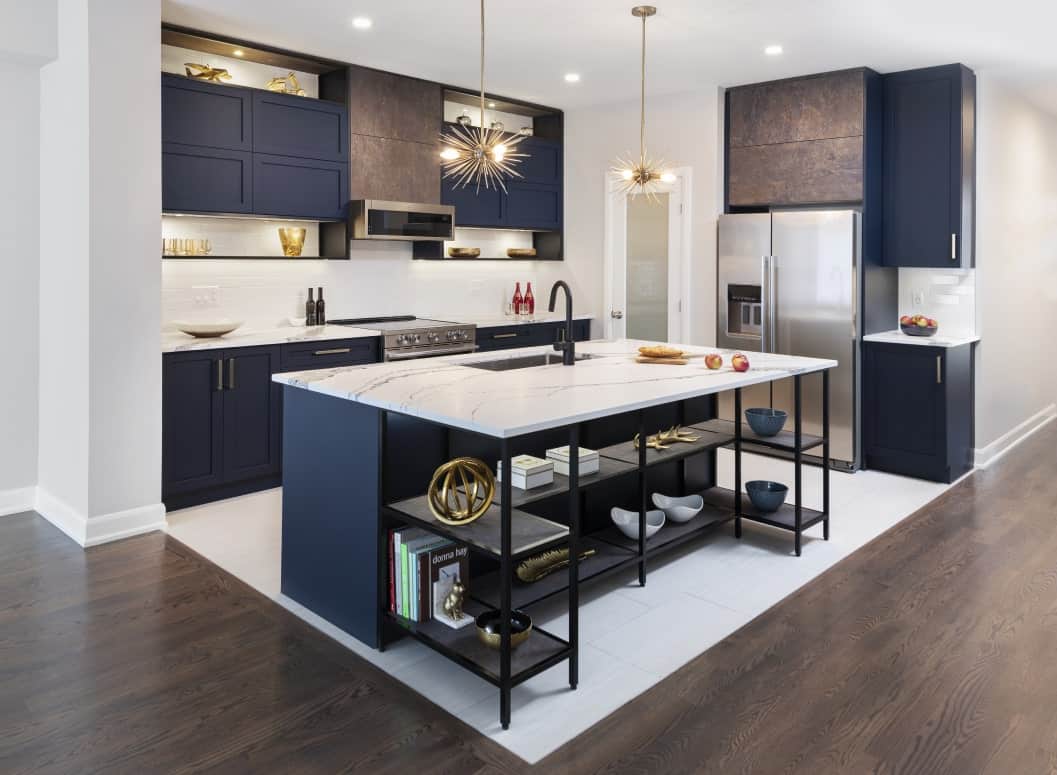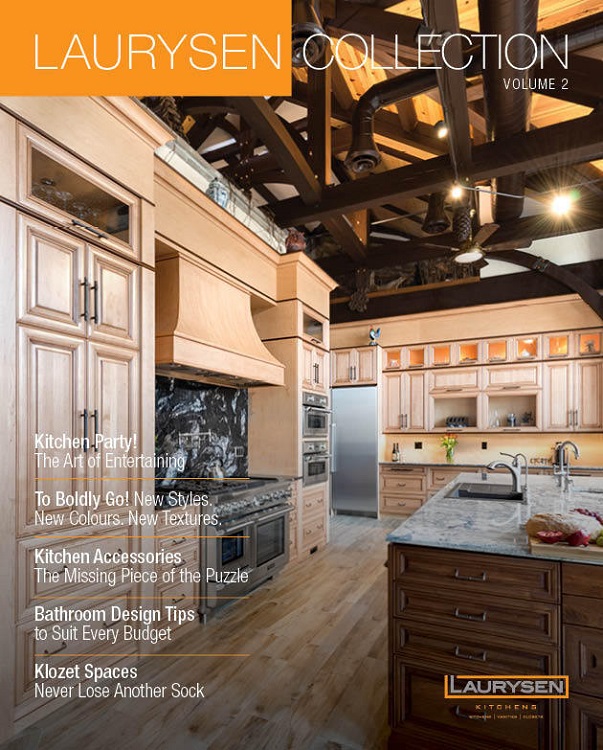Updated for 2025
Planning a kitchen renovation can be a lot of fun, but it’s also a bit confusing. There are so many different designs! However, once you understand the various kitchen styles, you’ll be better equipped to work with a designer and create your own very personal kitchen look.
We’ve defined, characterized and described each kitchen design to show readers the impact each style can have on the feel and look of your kitchen:
Best Modern Kitchen Designs
Classic Kitchen Design
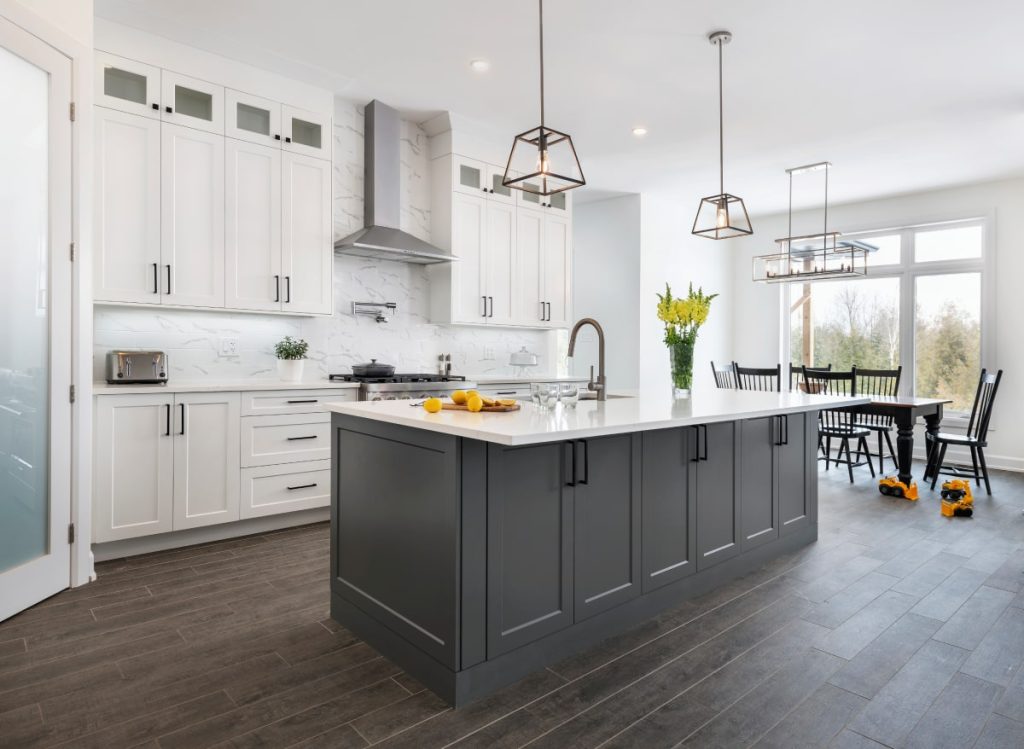
Definition: Classic kitchen design incorporates many of the principles of traditional kitchens but in a simpler, more restrained way.
Characteristics: A classic-style kitchen is fresh, light, and comfortable, offering universal appeal and timeless value.
Colours Used: White or cream is used abundantly (but the two never appear together) as a low-key background to an active kitchen. The one contrasting colour is often black, grey, or brown.
Materials Used: The focal point in a classic kitchen tends to be a marble or other stone counter with a luxe-honed (matte) finish or bullnose edge. Cabinets are made of wood, with a small, tasteful accent, such as a narrow strip of bead moulding.
Contemporary Kitchen Design
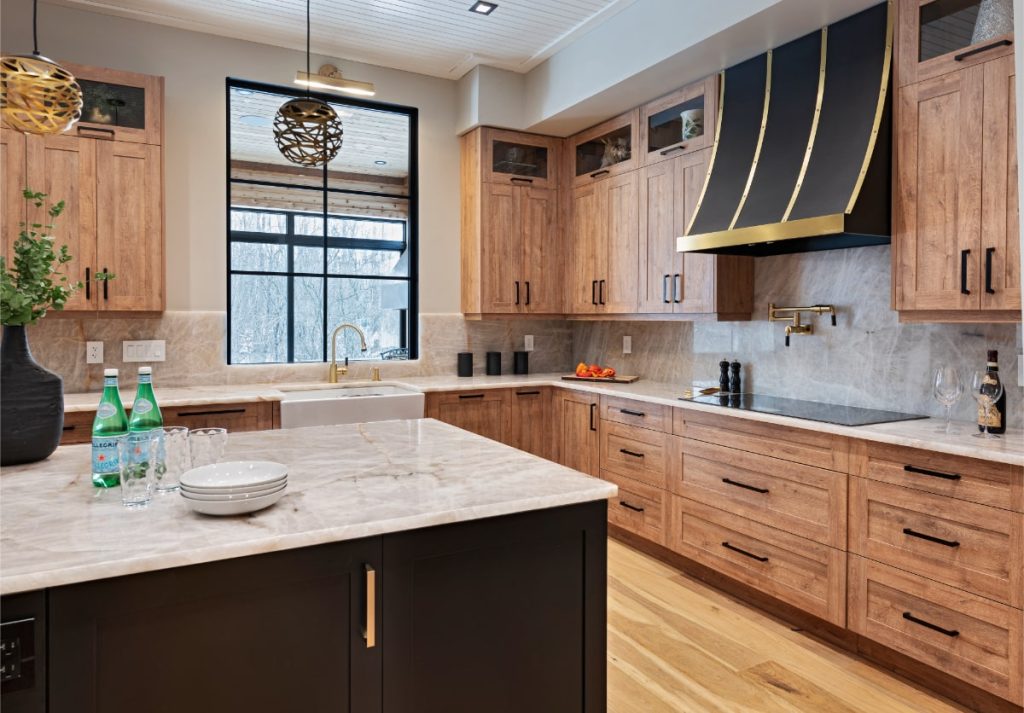
Definition: Contemporary kitchen design is continually evolving, incorporating styles that are currently on-trend.
Characteristics: Successfully designed contemporary kitchens tend to contain a playfully curated mix of the best fashions of various eras. Presently, there is an emphasis on openness, both open floor plan and open shelving instead of kitchen cabinets. Plenty of counter space and in-kitchen seating are essential; contemporary kitchens multitask as areas to gather the family and entertain guests.
Colours Used: In contemporary design, popular colours are a dramatic combination of dark cabinets with white counters. A few splashes of strong colour accent the room in the form of bright hand towels or wall art.
Materials Used: Kitchen island materials are often granite or marble in light shades. Metal is quite evident in stainless steel appliances, brushed nickel hardware, and chrome stools.
Transitional Kitchen Design

Definition: Transitional kitchen design style is best described as balanced; it blends the best of traditional and contemporary.
Characteristics: This design feels warm and welcoming. While generally simple (Shaker-style cabinets with plain hardware are a favourite), it usually includes one or two special features, such as a statement light fixture.
Colours Used: Serene neutral or pastel colours help set the transitional mood.
Materials Used: Wood is favoured for both cabinets and kitchen flooring. Countertops are constructed of natural material – marble, for example. Backsplash materials tend to be low-key, often classic subway tiles, although these may be offset or used in other slightly out-of-the-box ways.
Modern Kitchen Design
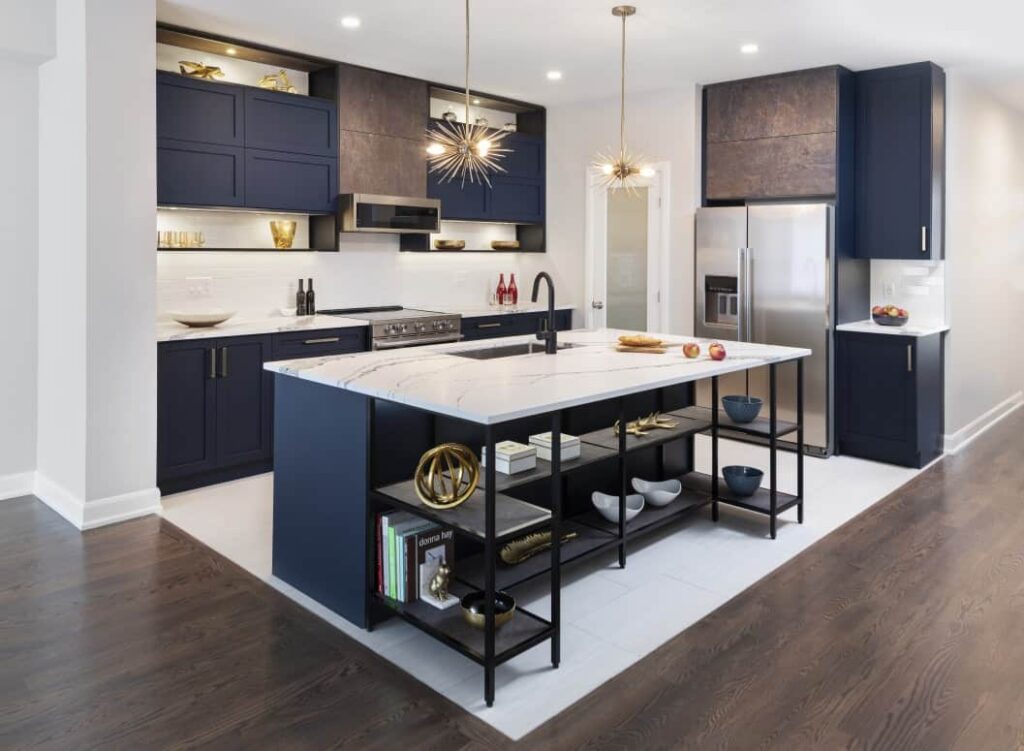
Definition: Modern kitchen style follows the Modernist design movement of the 1950s.
Characteristics: Modern kitchens are sleek, emphasizing strong horizontal lines, frameless cabinetry, plenty of negative space, and minimal clutter. The focus is heavily on fine craftsmanship since there are no frilly details to distract the eye.
Colours Used: White is abundant.
Materials Used: Materials like high-quality woods, rather than embellishments, are uber important. Reflective surfaces are common in modern kitchen design, whether lacquered slab cabinets or glossy quartz counters.
Traditional Kitchen Design

Definition: Traditional kitchen style is old-fashioned, ornate, expansive, and somewhat formal.
Characteristics: The hallmark of a traditional kitchen is elaborate furniture-style cabinetry, possibly enhanced by ”legs.” Cabinet doors often feature either raised panels or insets of glass or metal mesh. Mouldings and similar architectural details embellish the kitchen’s appearance.
Colours Used: Deep rich colours such as browns and beiges predominate.
Materials Used: Materials are usually natural and more suited for a natural-design kitchen. Wood is de rigueur for cabinetry, perhaps with rubbed brass hardware. Granite is popular for countertops. Sinks are often porcelain, apron-front or farmhouse style, with a decorative tile backsplash, which may include a mosaic or other artistic detail.
Beyond the Primary Kitchen Styles
Undoubtedly, you’ve encountered other kitchen design styles that seem to carry their own unique charm, character, or vibe. These designs feel distinct, yet many draw from the five primary styles we’ve introduced—Traditional, Contemporary, Transitional, Modern, and Classic—to offer something uniquely their own.
Whether it’s the cozy, rustic appeal of Farmhouse or the sleek, retro vibe of Mid-Century, these design styles often integrate modern kitchen ideas from many different styles to create a space that’s all your own.
Farmhouse Kitchen Design
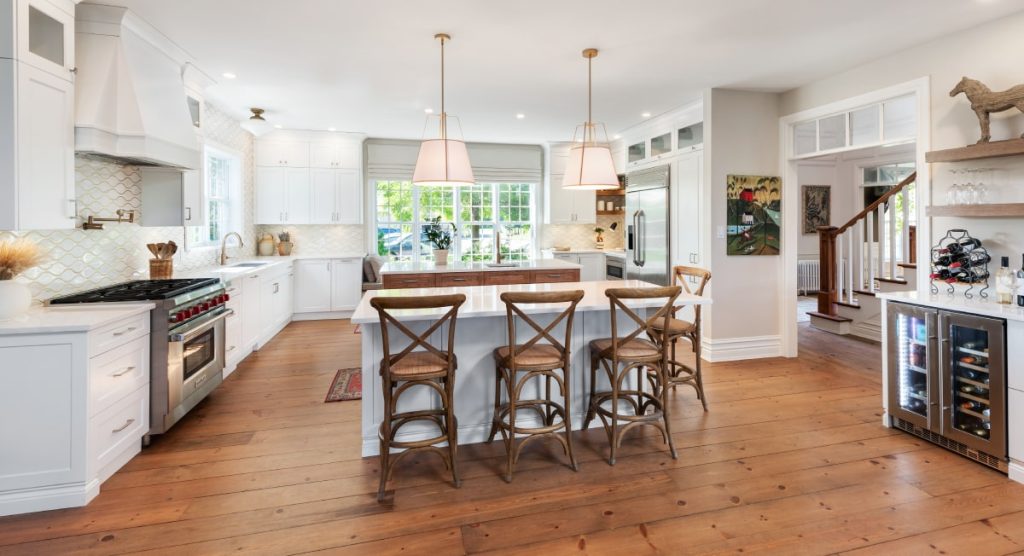
Definition: Farmhouse kitchen design is rooted in Traditional design but brings warmth, rustic charm, and elements of local rural heritage to create a welcoming atmosphere. This style instantly evokes a sense of nostalgia the minute you enter but still offers the modern convenience of a contemporary kitchen.
Characteristics: Farmhouse kitchens often feature open shelving, large apron-front sinks, and natural wood finishes. Cabinets are typically Shaker-style, with simple, clean lines, while reclaimed wood beams and vintage-inspired lighting add a sense of history. Large kitchen islands are a common focal point, perfect for gathering around.
Colours Used: Warm, neutral tones that you’d find in a typical farmhouse dominate the palette. Natural elements or pastel accents often complement whites, creams, and light greys.
Materials Used: Wood is plentiful and used throughout, from cabinets to flooring. Butcher block countertops are a classic touch, though quartz and granite can add a modern twist. Porcelain or stainless steel sinks complete the traditional farmhouse feel.
Cottage Kitchen Design

Definition: Cottage kitchens are meant to be charming and cozy. With a nod to traditional and classic designs, this style uses vintage-inspired touches to create a homey, welcoming, and relaxed atmosphere.
Characteristics: Beadboard panelling, open shelving, and soft, curving lines define the cottage kitchen look. Quaint cabinets featuring light or pastel shades, natural light, and floral patterns add to that homey, lived-in vibe. These elements combine to make smaller spaces feel perfectly protected and comfortable.
Colours Used: Light pastels, warm whites, and neutral tones are popular. Soft green cabinets or a pale blue island may accompany bright accents, such as patterned curtains and colourful dishware, to complete the quaint cottage feel.
Materials Used: Painted wood cabinets and floors are a hallmark of cottage kitchens. Marble or wood countertops maintain a clean, traditional theme, while vintage brass fixtures, glass cabinet doors and painted ceramic tiles can bring a cottage kitchen to life.
Rustic Kitchen Design

Definition: Rustic kitchens bring the beauty of the outdoors inside by using lots of wood and other natural materials, along with antique-looking metals, to create a warm and inviting environment. This style celebrates texture, rugged charm, natural imperfections, and organic beauty.
Characteristics: Exposed wooden beams, stone walls, and unvarnished wooden cabinetry define the rustic kitchen. You’ll see natural textures, open wood shelves, wrought iron drawer handles and light fixtures used to create a simple yet functional layout.
Colours Used: Earthy tones like browns, oranges, yellows, and deep reds help connect you to nature, creating a cozy and grounded space.
Materials Used: Reclaimed wood, stone, and farm metals help achieve a rustic vibe. Countertops can be made of granite or soapstone, while cabinets are usually solid wood with a distressed or weathered finish. Brick backsplashes complete the scene.
Beach Kitchen Design

Definition: Inspired by the easygoing charm of beach life, a beach kitchen design is light, breezy, natural, and relaxed. This style offers laid-back, simple comfort with modern pieces mixed in, perfect for anyone who wants to feel like they’re living ocean-side.
Characteristics: A beach kitchen feels light, bright, natural, and open. White or eggshell-coloured cabinets, large windows that invite in lots of natural light, and beach-inspired accents like driftwood, seashells, and starfish help create an airy feel. Simple lines, bohemian-style chairs, and open shelving create a sense of calm and space.
Colours Used: Soft blues, sandy beiges, and crisp whites form the foundation of a beach kitchen palette. Light wood finishes with pops of turquoise, blue, or green can also add to the coastal atmosphere.
Materials Used: All natural materials paired with light-toned wood cabinets and floors, quartz or marble countertops, and ceramic tile backsplashes add to the elegance. Nautical pieces like rope drawer pulls, weathered wood furniture and basket weave decor will complete the California look.
Mediterranean Kitchen Design
Definition: Mediterranean kitchens exude warmth, texture, and colours inspired by the kitchens and landscapes of Italy, Spain, and Greece. This design style blends modern comforts with old-world elegance and charm.
Characteristics: Wrought-iron fixtures, arched doorways, and colourful tilework are typical of Mediterranean kitchens. Dark wood cabinets may have ornate carvings, while countertops and backsplashes display vibrant mosaic tiles. The layout is open and inviting, with lots of dining space to accommodate large family gatherings. Plenty of natural light, plants, and clay pottery help to capture the essence of villa living.
Colours Used: Rich hues such as terracotta, mustard yellow, and deep blue are common in this style. Earthy tones, along with calming whites and warm woods, conjure the sun-soaked landscapes of the Mediterranean.
Materials Used: Wood, stone, and ceramic are essential ingredients in a Mediterranean kitchen. Natural stone countertops like granite or marble with painted ceramic tiles provide texture and colour.
Mid-Century Kitchen Design

Definition: Mid-century kitchen design blends the retro appeal of the 1950s and ‘60s with modern updates. This style is ideal for homeowners who love vintage aesthetics but still want the comforts and convenience of contemporary kitchens.
Characteristics: Mid-century kitchens are usually sleek and minimalist, with flat, slab-style cabinet doors, geometric backsplashes, and neutral tones with bold pops of colour. The design emphasizes functionality, with open layouts and streamlined appliances.
Colours Used: Timeless whites or taupes are coupled with moody greens or splashes of bright colours like mustard yellow, teal, and orange. The bold colours bring energy, while neutrals like white, grey, and wood tones create an overall balanced look.
Materials Used: Mid-century kitchens often feature oak, birch, and walnut cabinets, stainless steel appliances and fixtures, and laminate materials. Quartz countertops paired with tiled backsplashes—such as stacked, rectangular white tiles—add style to the space.
Shaker Style Kitchen Design
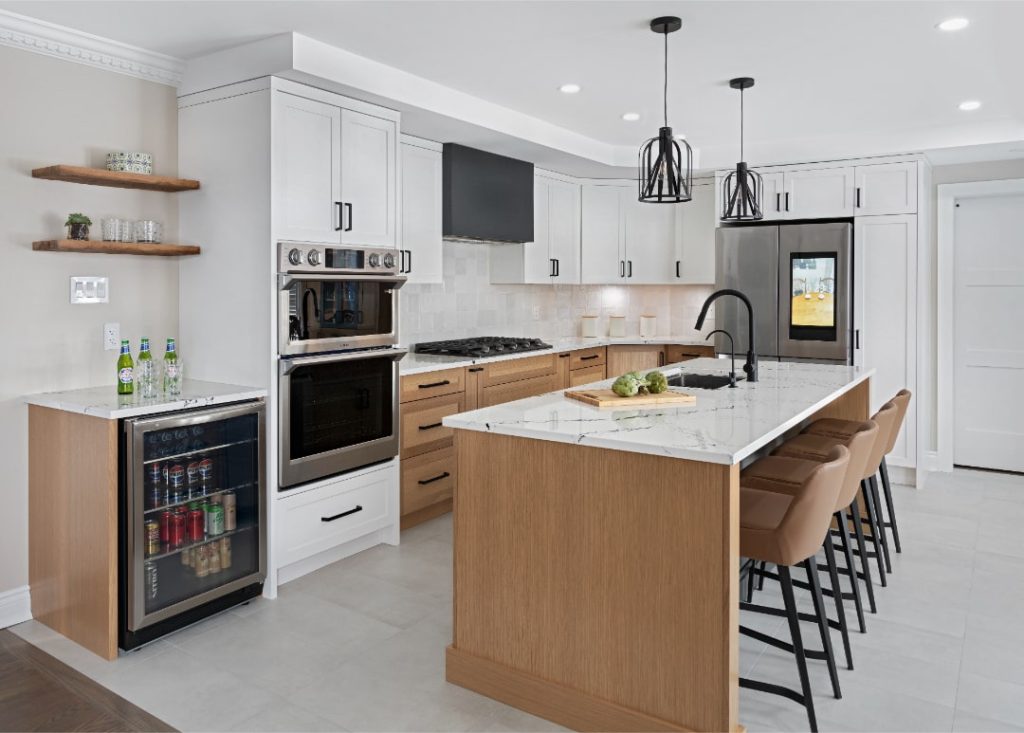
Definition: Shaker kitchens are rooted in 18th-century minimalism, inspired by the Shaker movement’s simplicity, old-time quality craftsmanship, and functional design. Clean lines and a timeless aesthetic take you back to the old world.
Characteristics: Shaker-style cabinets are characterized by flat-panelled doors with minimal detailing. Functional and practical layouts with natural materials are key characteristics. Open shelving and neutral colour schemes contribute to a clean, uncluttered look.
Colours Used: The colours in Shaker kitchens are understated, featuring neutral whites, greys, and soft pastels. These colours evoke a light, airy and calm feeling.
Materials Used: Lots of wood painted in neutral tones, paired with stone countertops, is a staple in Shaker kitchen design. Stainless steel or brushed nickel hardware introduces a modern touch, while wood floors or simple ceramic tiles complement the overall aesthetic.
Find Your Own Style
Now you’ve got the basics. The next move? Talking with a kitchen designer to decide which elements work best for you.
Contact Laurysen’s experienced kitchen designers to create a kitchen you’ll love.
